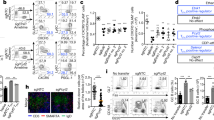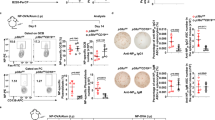Abstract
Subcompartments of the plasma membrane are believed to be critical for lymphocyte responses, but few genetic tools are available to test their function. Here we describe a previously unknown X-linked B cell–deficiency syndrome in mice caused by mutations in Atp11c, which encodes a member of the P4 ATPase family thought to serve as 'flippases' that concentrate aminophospholipids in the cytoplasmic leaflet of cell membranes. Defective ATP11C resulted in a lower rate of phosphatidylserine translocation in pro-B cells and much lower pre-B cell and B cell numbers despite expression of pre-rearranged immunoglobulin transgenes or enforced expression of the prosurvival protein Bcl-2 to prevent apoptosis and abolished pre-B cell population expansion in response to a transgene encoding interleukin 7. The only other abnormalities we noted were anemia, hyperbilirubinemia and hepatocellular carcinoma. Our results identify an intimate connection between phospholipid transport and B lymphocyte function.
This is a preview of subscription content, access via your institution
Access options
Subscribe to this journal
Receive 12 print issues and online access
$209.00 per year
only $17.42 per issue
Buy this article
- Purchase on Springer Link
- Instant access to full article PDF
Prices may be subject to local taxes which are calculated during checkout






Similar content being viewed by others
Accession codes
References
Malin, S., Mcmanus, S. & Busslinger, M. STAT5 in B cell development and leukemia. Curr. Opin. Immunol. 22, 168–176 (2010).
Ye, M. & Graf, T. Early decisions in lymphoid development. Curr. Opin. Immunol. 19, 123–128 (2007).
Mandel, E.M. & Grosschedl, R. Transcription control of early B cell differentiation. Curr. Opin. Immunol. 22, 161–167 (2010).
Nutt, S.L. & Kee, B.L. The transcriptional regulation of B cell lineage commitment. Immunity 26, 715–725 (2007).
Welner, R.S., Pelayo, R. & Kincade, P.W. Evolving views on the genealogy of B cells. Nat. Rev. Immunol. 8, 95–106 (2008).
Hardy, R.R., Kincade, P.W. & Dorshkind, K. The protean nature of cells in the B lymphocyte lineage. Immunity 26, 703–714 (2007).
Inlay, M.A. et al. Ly6d marks the earliest stage of B-cell specification and identifies the branchpoint between B-cell and T-cell development. Genes Dev. 23, 2376–2381 (2009).
Wei, C., Zeff, R. & Goldschneider, I. Murine pro-B cells require IL-7 and its receptor complex to up-regulate IL-7Rα, terminal deoxynucleotidyltransferase, and cμ expression. J. Immunol. 164, 1961–1970 (2000).
Melchers, F. The pre-B-cell receptor: selector of fitting immunoglobulin heavy chains for the B-cell repertoire. Nat. Rev. Immunol. 5, 578–584 (2005).
Fleming, H.E. & Paige, C.J. Pre-B cell receptor signaling mediates selective response to IL-7 at the pro-B to pre-B cell transition via an ERK/MAP kinase-dependent pathway. Immunity 15, 521–531 (2001).
Marshall, A.J., Fleming, H.E., Wu, G.E. & Paige, C.J. Modulation of the IL-7 dose-response threshold during pro-B cell differentiation is dependent on pre-B cell receptor expression. J. Immunol. 161, 6038–6045 (1998).
Lingwood, D. & Simons, K. Lipid rafts as a membrane-organizing principle. Science 327, 46–50 (2010).
Leventis, P.A. & Grinstein, S. The distribution and function of phosphatidylserine in cellular membranes. Annu Rev Biophys 39, 407–427 (2010).
Muthusamy, B.-P., Natarajan, P., Zhou, X. & Graham, T.R. Linking phospholipid flippases to vesicle-mediated protein transport. Biochim. Biophys. Acta 1791, 612–619 (2009).
Yeung, T. et al. Membrane phosphatidylserine regulates surface charge and protein localization. Science 319, 210–213 (2008).
Park, D. et al. BAI1 is an engulfment receptor for apoptotic cells upstream of the ELMO/Dock180/Rac module. Nature 450, 430–434 (2007).
Miyanishi, M. et al. Identification of Tim4 as a phosphatidylserine receptor. Nature 450, 435–439 (2007).
Dillon, S.R., Constantinescu, A. & Schlissel, M.S. Annexin V binds to positively selected B cells. J. Immunol. 166, 58–71 (2001).
Holder, M.J., Barnes, N.M., Gregory, C.D. & Gordon, J. Lymphoma cells protected from apoptosis by dysregulated bcl-2 continue to bind annexin V in response to B-cell receptor engagement: a cautionary tale. Leuk. Res. 30, 77–80 (2006).
Pomorski, T. & Menon, A.K. Lipid flippases and their biological functions. Cell. Mol. Life Sci. 63, 2908–2921 (2006).
Tang, X., Halleck, M.S., Schlegel, R.A. & Williamson, P. A subfamily of P-type ATPases with aminophospholipid transporting activity. Science 272, 1495–1497 (1996).
van der Velden, L.M., van de Graaf, S.F.J. & Klomp, L.W.J. Biochemical and cellular functions of P4 ATPases. Biochem. J. 431, 1–11 (2010).
Paulusma, C.C. & Elferink, R.P.J.O. P4 ATPases–the physiological relevance of lipid flipping transporters. FEBS Lett. 584, 2708–2716 (2010).
Bull, L.N. et al. A gene encoding a P-type ATPase mutated in two forms of hereditary cholestasis. Nat. Genet. 18, 219–224 (1998).
Siggs, O.M. et al. The P4-type ATPase ATP11C is essential for B lymphopoiesis in adult bone marrow. Nat. Immunol. advance online publication, doi:10.1038/ni.2012 (20 March 2011).
Ogilvy, S. et al. Constitutive Bcl-2 expression throughout the hematopoietic compartment affects multiple lineages and enhances progenitor cell survival. Proc. Natl. Acad. Sci. USA 96, 14943–14948 (1999).
Mertsching, E., Grawunder, U., Meyer, V., Rolink, T. & Ceredig, R. Phenotypic and functional analysis of B lymphopoiesis in interleukin-7-transgenic mice: expansion of pro/pre-B cell number and persistence of B lymphocyte development in lymph nodes and spleen. Eur. J. Immunol. 26, 28–33 (1996).
Goodnow, C.C. et al. Altered immunoglobulin expression and functional silencing of self-reactive B lymphocytes in transgenic mice. Nature 334, 676–682 (1988).
Phan, T.G. et al. B cell receptor-independent stimuli trigger immunoglobulin (Ig) class switch recombination and production of IgG autoantibodies by anergic self-reactive B cells. J. Exp. Med. 197, 845–860 (2003).
Gall, W.E. et al. Drs2p-dependent formation of exocytic clathrin-coated vesicles in vivo. Curr. Biol. 12, 1623–1627 (2002).
Hua, Z., Fatheddin, P. & Graham, T.R. An essential subfamily of Drs2p-related P-type ATPases is required for protein trafficking between Golgi complex and endosomal/vacuolar system. Mol. Biol. Cell 13, 3162–3177 (2002).
Alder-Baerens, N., Lisman, Q., Luong, L., Pomorski, T. & Holthuis, J.C.M. Loss of P4 ATPases Drs2p and Dnf3p disrupts aminophospholipid transport and asymmetry in yeast post-Golgi secretory vesicles. Mol. Biol. Cell 17, 1632–1642 (2006).
Kikuchi, K., Lai, A.Y., Hsu, C.-L. & Kondo, M. IL-7 receptor signaling is necessary for stage transition in adult B cell development through up-regulation of EBF. J. Exp. Med. 201, 1197–1203 (2005).
Malin, S. et al. Role of STAT5 in controlling cell survival and immunoglobulin gene recombination during pro-B cell development. Nat. Immunol. 11, 171–179 (2010).
Henriques, C.M., Rino, J., Nibbs, R.J., Graham, G.J. & Barata, J.T. IL-7 induces rapid clathrin-mediated internalization and JAK3-dependent degradation of IL-7Rα in T cells. Blood 115, 3269–3277 (2010).
Alves, N.L., van Leeuwen, E.M.M., Derks, I.A.M. & van Lier, R.A.W. Differential regulation of human IL-7 receptor α expression by IL-7 and TCR signaling. J. Immunol. 180, 5201–5210 (2008).
Park, J.-H. et al. Suppression of IL7Ralpha transcription by IL-7 and other prosurvival cytokines: a novel mechanism for maximizing IL-7-dependent T cell survival. Immunity 21, 289–302 (2004).
Zech, T. et al. Accumulation of raft lipids in T-cell plasma membrane domains engaged in TCR signalling. EMBO J. 28, 466–476 (2009).
Xu, C. et al. Regulation of T cell receptor activation by dynamic membrane binding of the CD3epsilon cytoplasmic tyrosine-based motif. Cell 135, 702–713 (2008).
Aivazian, D. & Stern, L.J. Phosphorylation of T cell receptor zeta is regulated by a lipid dependent folding transition. Nat. Struct. Biol. 7, 1023–1026 (2000).
Cho, J.-H., Kim, H.-O., Surh, C.D. & Sprent, J. T Cell receptor-dependent regulation of lipid rafts controls naive CD8+ T cell homeostasis. Immunity 32, 214–226 (2010).
Rose, T. et al. Interleukin-7 compartmentalizes its receptor signaling complex to initiate CD4 T lymphocyte response. J. Biol. Chem. 285, 14898–14908 (2010).
Dillon, S.R., Mancini, M., Rosen, A. & Schlissel, M.S. Annexin V binds to viable B cells and colocalizes with a marker of lipid rafts upon B cell receptor activation. J. Immunol. 164, 1322–1332 (2000).
Wu, C. et al. BioGPS: an extensible and customizable portal for querying and organizing gene annotation resources. Genome Biol. 10, R130 (2009).
Nelms, K.A. & Goodnow, C.C. Genome-wide ENU mutagenesis to reveal immune regulators. Immunity 15, 409–418 (2001).
Mombaerts, P. et al. RAG-1-deficient mice have no mature B and T lymphocytes. Cell 68, 869–877 (1992).
Randall, K.L. et al. Dock8 mutations cripple B cell immunological synapses, germinal centers and long-lived antibody production. Nat. Immunol. 10, 1283–1291 (2009).
Langmead, B., Trapnell, C., Pop, M. & Salzberg, S.L. Ultrafast and memory-efficient alignment of short DNA sequences to the human genome. Genome Biol. 10, R25 (2009).
Li, H. et al. The Sequence Alignment/Map format and SAMtools. Bioinformatics 25, 2078–2079 (2009).
Hanada, K. & Pagano, R.E. A Chinese hamster ovary cell mutant defective in the non-endocytic uptake of fluorescent analogs of phosphatidylserine: isolation using a cytosol acidification protocol. J. Cell Biol. 128, 793–804 (1995).
Acknowledgements
We thank the staff of the Australian National University Bioscience Research Services for animal husbandry; the Australian Phenomics Facility genotyping and mapping team for genetic analysis; D. Howard for help with the bone marrow chimeras; A. Bröer for help with the flippase assay; staff of the John Curtin School of Medical Research microscopy and flow cytometry resource facility for help with flow cytometry; the Biomolecular Resource Facility of the Australian Cancer Research Foundation and the Australian Genome Research Facility for DNA sequencing; and K. Peng (Biomolecular Resource Facility of the Australian Cancer Research Foundation), John Curtin School of Medical Research and the Australian Genome Research Facility Next Generation Sequencing and Bioinformatics teams, Brisbane, for preparing and running samples in parallel for next-generation sequencing. Supported by the National Institutes of Health (C.C.G.), Wellcome Trust (C.C.G.), the Australian Research Council (C.C.G.), the National Health and Medical Research Council (C.C.G.), the Ramaciotti Foundation (C.C.G. and A.E.), the Ministry of National Education, Republic of Turkey (M.Y.) and Deutsche Forschungsgemeinschaft (EN 790/1-1 to A.E.).
Author information
Authors and Affiliations
Contributions
M.Y. did and analyzed most of the experiments; C.E.T., S.F., D.L. E.M.K., J.K. and A.E. contributed to experiments; C.M.R. and A.E. identified the ATP11C-mutant strains; B.W., D.T.A., Y.Z. and A.E. mapped and identified the mutation in the ambrosius strain; N.C.T. and G.C.F. analyzed liver histology and clinical chemistry; S.B. helped with the flippase assay; C.C.G. and A.E. conceived of the research and directed the study; and M.Y., C.C.G. and A.E. prepared the figures and wrote the paper in consultation with all authors.
Corresponding authors
Ethics declarations
Competing interests
The authors declare no competing financial interests.
Supplementary information
Supplementary Text and Figures
Supplementary Figures 1–10 (PDF 3222 kb)
Rights and permissions
About this article
Cite this article
Yabas, M., Teh, C., Frankenreiter, S. et al. ATP11C is critical for the internalization of phosphatidylserine and differentiation of B lymphocytes. Nat Immunol 12, 441–449 (2011). https://doi.org/10.1038/ni.2011
Received:
Accepted:
Published:
Issue Date:
DOI: https://doi.org/10.1038/ni.2011
This article is cited by
-
ATP11C promotes the differentiation of pre-B cells into immature B cells but does not affect their IL-7-dependent proliferation
Immunologic Research (2023)
-
Atp8a1 deletion increases the proliferative activity of hematopoietic stem cells by impairing PTEN function
Cellular Oncology (2023)
-
The role of phosphatidylserine on the membrane in immunity and blood coagulation
Biomarker Research (2022)
-
The ratio of ATP11C/PLSCR1 mRNA transcripts has clinical significance in sickle cell anemia
Annals of Hematology (2022)
-
Of membranes and malaria: phospholipid asymmetry in Plasmodium falciparum-infected red blood cells
Cellular and Molecular Life Sciences (2021)



